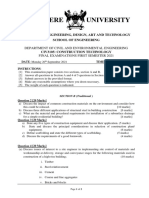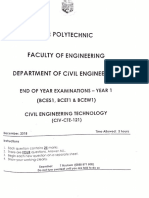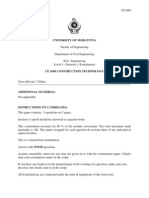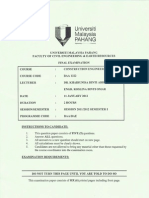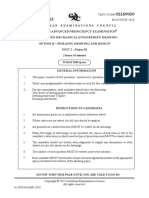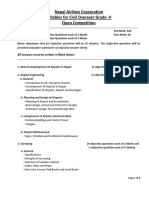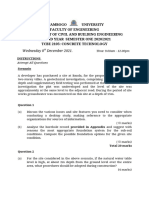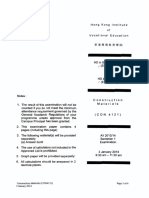0% found this document useful (0 votes)
15 views20 pagesEngineering Technology
applies scientific and mathematical principles to solve practical problems by focusing on the implementation, operation, and maintenance of existing technologies, rather than the theoretical design of new ones.
Uploaded by
birungigeoffrey16Copyright
© © All Rights Reserved
We take content rights seriously. If you suspect this is your content, claim it here.
Available Formats
Download as PDF or read online on Scribd
0% found this document useful (0 votes)
15 views20 pagesEngineering Technology
applies scientific and mathematical principles to solve practical problems by focusing on the implementation, operation, and maintenance of existing technologies, rather than the theoretical design of new ones.
Uploaded by
birungigeoffrey16Copyright
© © All Rights Reserved
We take content rights seriously. If you suspect this is your content, claim it here.
Available Formats
Download as PDF or read online on Scribd
/ 20
ha
- D
NATIONS B BoAR!
UGANDA BUSINESS AND TECHNICAL EXAM EXAMIN: OE
_
= - DATE
PAPER CODE PROGRAMME
TUESDAY,
LOMA IN CIVIL
wee | eveneenc pou poysnay q
x > ‘Bejs aoewny seq 8
ar ean aD
- Se
fst aoa puey se pasn sjeLayeyy E11'9
Jsjow SujwWos9q Uodn [Jas JOU Pinoys»
aN J2HEW jnjuuzey soyRo 40 aEYdIns ajqonyes JaIEM wioy 3ayj 99 plnoyg
& aiqeinp pue Suons oq pjnoyg
‘9409 puty poos & yo sonyend 71 1°
6
‘vase 282] B 980 speo} tu1od puasds yy
0} punosd ay Woy aumysiows Jo Sur 5
as Supying ay BUI 3]qBI989A JO INLOI suaAaid ]
Is B¥a10u09 oO punods seo O1 Yor Uodn aseq [9A9] e sapIACId a]
i
on
nn
eX (uonse Areyideo swuansid) quis:
"827
3
Eg length=0.3m, width=0.3m
Depth =0.0347m°/(0.3x0.3)m?
Depth =0.386m
Size of gauge box=(300x300x386) mm.
imix it with 2pauge boxes of sand and 4 gauge boxes
ni gauze box, pick | bag of cemen
negates,
6.163 Functions of each ingredient in the concrete mix
immediately after
t of cement paste fom fluid 10 rigid state and takes place im
me cme with wae whic hrdeningot come a stengh tino es nese
over a period of time.
+ Water | .
$ Allows cement to hydrate. (Hydration is a chemical reaction between cement and water
allowing cement to set and harden). _ : ;
Water also increases workability of concrete which in turn enables constituents to be mixed
~-
: together and compacted easily.
iii) Coarse aggregates ’ . \.'
It provides bulkiness to the concrete mix and contributes to final strength oFconcrete. Mw ae
* Reduces drying shrinkage in concrete oe 2 ea
* Reduces the cost of concrete : 2 sec
iv) Fine aggregate/sand
* __Itfills spaces between coarse aggregates, making the concrete more dense and less
porous
produce grout that can produce smooth surface of
Combines with cement and water to
concrete when it hardens.
%) — Admixture
May improve the workability of concrete
Delays or accelerates setting time of concrete
[fore commencing on batching of concrete materials, a design team specifies the concrete grade to
be used fora particular project.
After specifying the grade of concret
such concrete grade/strength,
eto be used, the contractor will prepare a design mix to achieve
6.164 Some of the common concrete grades in common use are
2
* M25, this corresponds to a mix proportion of
$ M20, thi corresponds toa mix proportion of |:1.5:3
MIS. this corresponds to a mix proportion of 1:24
{ MIO, this corresponds toa mix proportion of 1:3:6
.
M7.5, this corresponds 1 a mix proportion of [:4:8
MS, this corresponds to a mix proportion of 1:5-10
M- Stands for mix, 25 means : :
28 days or mix, 25 thal the compressive strength of the concrete is 25N/mm’ after a period
‘170 mixing of concrete
There are basically two methox of mixing concrete, ie
© Mixing by hand
Mixing by machine
6.171 Mixing by hand
The following procedure is undertaken when mixing concrete bry hand
+ Measure the required proportion of fine aggrepate ether By volume om co see re
Mix it dey with the required proportion of cement ona clea, dy surface.
r until sand grain is uniformly coated /mixed with cement
‘© Spread the mixture on the clean, dry and hard surface _ i
Measure the required proportion of coarse aggregate by the similar method and spread
the mixture of cement and sand.
; . tiably
Pour the required amount of water in the mix control : |
By use of hand hoes or shovels, turn the ingredients several times until a workable and
* Nomogenous concrete is produced ready for transportation.
6.172 mixing by machine (mixer)
; a it i i been started. The mixer
In this method, the batched ingredients are poured into the mixer which has rt
will mix the concrete ingredients as it rotates. The concrete is discharged when properly mixed.
There are two main categories of mixers, ie batch and continuous mixers .
1. Batch mixers
‘These types of mixers produce concrete one batch at a time. The concrete is emptied completely after
cach mixing cycle and ingredients reloaded for the next batch. anh
There are two main types of batch mixers, ie drum and pan batch mixers
a) Drum batch mixers
Drum mixers have a container /drum and the blade attached to inside part. It is the dram which
j) Totates. And as it rotates the blade lift the concrete ingredients and drops back into the mixer in each
| rotation of the drum. They are further categorized as tilting drum batch mixer, non-tilting drum batch
* mixer and reversing drum batch mixer.
f i) Tilting drum batch mixer
angle of about 15° When the mixing is done the drum is further tilted to
The drum is made to tilt at an
discharge the concrete.
ii) Non-tilting drum batch mixer
Materials re loaded from one end and discharged from the other end.
lil) Reversing drum batch mixer
‘The drum rotates in one direction for mixing and the other direction for discharging concrete.
b) Pan batch mixer
This type of batch mixer has one or two
y f blades attached inside the tk
blade which rotates inorder to mix the core a. i an. And it is the
the bottom trap. ‘omix the concrete. To discharge the concrete pan is emptied at
re Crt o2BY
ara constant rate. The constitwen
2. Continuous mixer
from the other end.
ine duces eancret
hich prod
ni
's fresh concrete is dischare
This is a type of m
loaded from one end a
rtation of concrete
from the mixing plant to the construction site or to the place 10 be canted.
fe fron
portation to ensure that bleeding, segregation and drying out do oct
6.180 trans}
This is a transfer of concret
Care must be taken during. tran
‘occur in concrete.
6.181 methods of transporting concrete
Mortar pan
it level, eg
this i crete i jed in small quantity that may be casted above ground level, ez
inclu, bea coe reals great Toss of water especially during hot weather concreting due to
in columns, beams, etc. |
greater exposure of concrete surfaces
‘The pan should be clean and wet at the start of the work.
‘Wheel barrow
This is used to transport concrete at ground level. It may lead to segregation of concrete duc to
vibration especially if the ground is rough and the haul distance is long. It should therefore be
provided with pneumatic wheel.
Crane bucket and rope way
This is used to transport concrete above ground level, it can move vertically, horizontally or in an
inclined way. Its common called 2 or 3 dimensional transport.
Chutes
Iti used to transport concrete from ground level to levels below the ground.
Transit mixer
This is a mixer mounted on the truck that keeps on agitatir i
t agitating at a speed of 2-6 revol i
truck moves. A small pump is fixed on the truck for discharging ee tis Sermuaaea ote
oncrete where the distance between the mixing plant and the sit is long.
Belt conveyors
‘These are used for small horizontal distances ranging from 5-10 Metres where access is limited.
is limi
Pump and pipes
Dumpers and trucks
hese are ordinary o, —
a. pen steel tiy
Segregation due to jolting during wae lores wa for long haul in horizontal
* weather condition Ne yl
* size of construction we
© topography x
* location of mixing plant from the site F
* type of construct
6.190 placing of concrete
vo This isa technique where wet concrete is poured init final postion. Concrete aul Powe from
a point which is as low as possible to prevent segregation where aggregates fall fist and settle down
leaving cement and sand paste to fall last and settle on top.
Before concrete is placed, the following must be taken into account;
+ Formwork must be properly erected to support wet concrete or to achieve the desired shape
* Incase of reinforced concrete, reinforcement bars needs to be laid properly in position, with
proper concrete cover. .
* All service pipes where need be should be properly laid in their positions. ,
6.200 compaction of concrete
This @ process by which entrapped air from freshly placed concrete is expelled by compressing
together the concrete ingredients in order to increase concrete density. However over compaction
leads to segregation and bleeding of concrete. When water present in concrete is pushed upwards due
‘0 settlement of cement and aggregate it leads to bleeding.
6.210 purposes of concrete compaction
To increase ultimate strength of concrete
To enhance bond of concrete with reinforcement
To increase abrasion resistance of concrete
To increase durability of concrete by reducing void ration or porosity
To force concrete to fill all corners and shape of the form
6.220 methods of compaction
| There are basically two main methods of compaction, ie manual compaction and machine compaction — ("
a) Manual compaction ee
, This is carried out by rodding, ramming or tamping the concrete with steel rodsetc. **
b) Mechanical compaction (machine)
i) Internal vibrator/ porker/needle
It is inserted into the concrete and started to vibrate the concrete from inside
ii) External vibrator
It vibrates concrete from the external surface.eg it can be made to vibrate form work
6.300 curing of concrete
Wiseaimated tha Ae attains S0% of js teenth won even within 3-7 days, 74%6 of ts
callout hat cacrt tae 30% of en
Mrength after 14 days and 80% of its by 28" day oF
310 rea
ns for curing concrete
When adequate amount of moisture is minint ne In
developing strength, volume stability, resistanee fete
is softening or melting of a material us a result of he
«hydration reaction contin
+ thawing, abrasion and scaling,
ing,
6.320 methods of curing
1) Water curing,
i) Lmmersion method
Concrete is immersed in the curing tank. Normally used to cure conerete cubes
ii) Ponding method
‘Small rectangular or square ponds are created on the: Surface of the slab by clay sand or lean
‘mortar and then water is poured in the ponds. Commonly used to cure floor slabs
i) Spraying
Water is sprayed on the surface ofthe conerete continuously during curing period,
iv) Dripping method
A poniainer of waters hanged over the concrete to be cured, Water is made to drip through small
hole erated on the container tothe concrete, Commonly used ta car: concrete columns.
2) Membrane curing
Plastic sheeting made from polythene,
'sed to cover concrete after 1 or 2 days of casting to seal off
evaporation of water from the concrete.
3) Steam curing
Heat is applied with addition of moisture to thi
yadoprag to accelerate hydration process and resulting
in faster. ‘Strength development. It is common
ly adopted in very cold climates,
AB construction co Itd has been
awarded a contrac
Measuring 10mx6m with the foll
a contract to construct a concrete round floor slab for a hall
lowing. Specifications;
Grade M15 concrete slab with mix Proportion of 1:2:4, thickness of 150mm. to used.
Water cement ratio of 45%
Sand blinding of Somm thick
Hard core 200mm. thick
Gauge 1200 Polyethylene sheet DPM.
Assume 54% shrinkage (when ‘Water is added to the )
-
Ve 10x6x0.15 9m"
1%, Ve 1.549!
Add s
Ve13.86M"
Cement
Considering the mix proportion specified,
1.98’
Volume of cement only 13.86x1/ (14244)
Density of cement=1440kg/m*
Mass of cement=VxD_ =1,98x1440=2851.2kes
1 bag of cement=50ks
NOs. of bags needed=2851.2/5057.024 bags .
Consider 57 bags of cement
Water
Considering water cement ratio of 45%,
Quantity of water-0.45x28511-2kgs=1283.04kgs
Consider 1283 litres of water
Fine aggregate
Volume of sand=13.86x2/(1+2+4)=3.96m"
sity of sand ranges from 1450-1500kg/m"
ass of sand =1450x3.96=5742kgs or 5.742 tons
‘Consider 6 tons of sand for mixing concrete
Blinding
Volume=10x6x0.05=3m*
Mass=1450x3=4350kgs=4.35 ton
Consider 5 tons of sand for blinding
Coarse aggregates
Volume of course aggregate =13.86x4/(1+2+4)=7.92m?
Density of aggregate ranges from 1450-1550kg/m?
Mass of aggregate needed=1450x7.92=1 1484kgs=I 1.484t0ns
Consider 12 tons of coarse aggregates
Nard core
Volume of hard core =10x6x0.2= 12m?
Den:
Y of hard core ranges from 2100-2300kg/m*
Mass of hard core needed= 12x2100=25200kgs~25.2tons
DPM
Numbers of DPM needed=10x6/(2x25)=1.2,
We need 2 rolls of DPM size 0.3mmx2mx25m*
References;
Z Sidley, R. and Greeno R( 2006), Building
° Bhavikalli, SS, (2010), Basic civil Engineeri
* Andrew J, Charlett and Craig Maybere-Thoy
construction hand book
ing New age intemational
was Fundamental building technology 2 edition
edition
